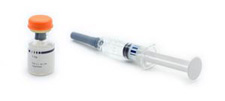Insulin Overdose

Facts about an Insulin Overdose
An insulin overdose is one of the complications that can come with diabetes. Most people with Type 1 diabetes and type 2 diabetics, who have a hard time controlling their blood sugar levels with oral medication, take insulin to treat their diabetes. When you don’t eat enough or you take too much insulin, you will suffer from an insulin overdose.
An insulin overdose causes hypoglycemia, otherwise known as low blood sugar. The symptoms are trembling hands, cold sweats, anxiety, and often feeling confused. In type 1 diabetes, no insulin is produced by the body, so insulin has to be injected. In type 1 diabetes, insulin is in the body but either there is not enough or the body’s cells are resistant to it.
In either case, people with diabetes have to take insulin to lower their blood sugar levels. But, just as your blood sugar can get too high from too much sugar intake, it can also get too low from too little sugar intake. There are many different reasons for an insulin overdose. You could have made a mistake, such as reading the syringe incorrectly and giving yourself too big a dose. Perhaps, you gave yourself the right amount but then you didn’t eat properly or missed a meal. That also results in too much insulin in your system. And, some people take two types of insulin and can give themselves too much of one and too little of the other.
The symptoms of insulin overdose are the ones listed above: sweating, trembling, anxiety, confusion and can also include extreme irritability, hunger, and intense fatigue. If nothing is done and blood sugar levels continue to drop, the diabetic could start having seizures and eventually would fall into unconsciousness. For people who test their blood sugars several times during the day, anytime the number falls to 70 or below, you are in the low blood sugar range.
If you have diabetes, make sure that your family and friends know the signs of an insulin overdose and what to do to help you. Also let people at work or school know what to do should you start to develop these symptoms. It is easy to get rid of the symptoms and get your glucose level back on track.
If possible, the first thing you should do is check your blood sugar level to see if it is 70 or below. If you don’t have your blood testing kit with you, assess your symptoms, and if they are right for an insulin overdose, take immediate action by drinking a half a cup of fruit juice or a soda with sugar. This is not the time for diet soda. If you have hard candy available, eat one or two. Buy something sweet and read the package or have someone do it for you. You need to take in around 15-20 grams of carbohydrates to raise your blood sugar to a safe level.
The next thing to do is just sit and rest. Wait for fifteen to twenty minutes to go by and then retake your blood sugar level if you have a test kit. If your sugar level is still low, eat something else with a goodly amount of carbohydrates in it. Your symptoms should be improving. If you wait an hour and you still cannot raise your blood sugar level and the symptoms do not disappear, call 911 immediately. This is a serious situation.
If you are with someone, tell them what is happening and have them get you the juice or another food high in sugar. Tell them if you pass out, to dial 911 and tell the ambulance attendants you are a diabetic with an insulin overdose.
Do as much as you can to prevent insulin overdoses. Always double-check your syringe before administering the dose. Make sure to eat regularly scheduled meals. Do not skip a meal. Make sure to carry hard candies with you in your car, pocket or handbag when you go out. And tell family and friends the signs of an insulin overdose and what they should do if you develop the symptoms.